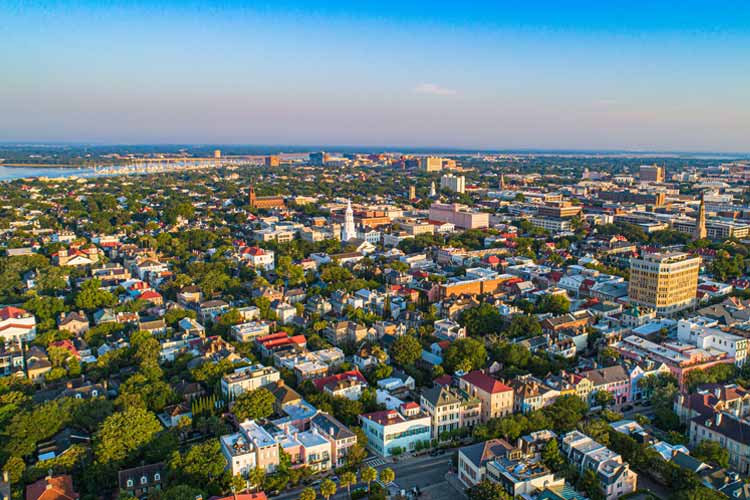
What Is a Flood Zone?
Every home or neighborhood has at least some flood risk. It’s important to know whether you live in a high-risk, low-risk, or moderate-risk flood area.
The easiest way to find out if your South Carolina home is located in a flood zone is to visit the website of the National Flood Insurance Program (NFIP), FloodSmart.gov. The Flood Map Service Center provides flood maps for communities across the US.
Flood maps depict a community’s flood risk, including the flood zone, floodplain boundaries, and base flood elevation. These can help you determine your flood insurance requirements and get an idea of how much a flood insurance policy might cost.
Remember that while flood insurance isn't required by the state of South Carolina, your mortgage lender will likely require it if you live in a high-risk flood zone. Here’s how to evaluate your flood risk based on the flood maps.
LOW RISK FLOOD AREAS: ZONES X, B, C
- 26% of flood claims occur in these zones
- Flood insurance is not required
- Flood insurance is less expensive
HIGH RISK FLOOD AREAS: ZONES A, V
- 74% of flood claims occur in these zones
- Flood insurance is likely required by your mortgage lender
- Flood insurance is more expensive
What Are the Most Flooded Areas in South Carolina?
In South Carolina, flooding occurs due to severe thunderstorms, hurricanes, seasonal rains, and other weather-related conditions. The state's low-lying coastal topography combined with its humid subtropical climate makes it highly vulnerable to inland or river flooding as well.
River flooding occurs when the flow of rainwater runoff is greater than the carrying capacities of the natural drainage systems. Coastal flooding, on the other hand, is usually the result of a severe weather system such as a tropical storm or hurricane. The damaging effects of coastal floods are caused by a combination of storm surge, wind, rain, erosion, and battering by debris.
Flood hazard areas are areas located within the 100-year floodplain, which are defined as any area that has a one (1%) percent chance of flooding in any given year. Smaller scale floods (50-year and 10-year) have a greater chance of occurring in any year and can pose a significant flood hazard to people and property close to the ocean, sound, drainage channels, and streams. Floods larger than the 100-year event can also occur.
To find out what flood zone your property is located within or what the most flooded areas of the state are, FEMA has a searchable map provided for free on their website.
Is Flood Insurance Required in a Flood Zone?
Property owners in high-risk flood areas may be required to have flood insurance.
Homes and businesses in high-risk flood areas with government-backed mortgages are required to have flood insurance. While flood insurance is not federally required if you live outside of the high-risk area, your lender may still require you to have insurance.
If you live in a high-risk flood area and have received federal disaster assistance, including grants from the Federal Emergency Management Agency (FEMA) or low-interest disaster loans from the US Small Business Administration (SBA), you must maintain flood insurance in order to be considered for any future federal disaster aid.
Remember, the NFIP stresses that nearly 25% of all flood insurance claims come from properties outside of high-risk flood areas. In addition, those who live outside of high-risk flood areas receive one-third of the federal disaster assistance for flood related disasters. Disaster assistance is usually in the form of a loan that must be paid back, with interest.
On the other hand, those who live in a low- to moderate-risk areas may be eligible for a Preferred Risk Policy, which can be very affordable and will provide both building and contents coverage. The annual premium for a Preferred Risk Flood Insurance Policy will likely be far less than the cost of making repair on your own, or paying back a federal disaster loan.
If you live in a Non-Special Flood Hazard Area (an area that has been designated low- to moderate-risk for flooding), it is important that you weigh the pros and cons of purchasing flood insurance.
Do I Need an Agent to Purchase Flood Insurance in South Carolina?
Flood insurance can only be purchased from your insurance agent, not directly from the federal government. When you apply for federal flood insurance, there will be a thirty-day waiting period after you have completed the application and made the first premium payment for the policy to become effective.
Your agent can help you learn about whether or not you live in a flood plain or a high-risk zone, and can get you quotes for flood insurance in your South Carolina community.
Article Reviewed by | Paul Martin
https://www.charleston-sc.gov/327/Flood-Zones
https://www.scemd.org/prepare/types-of-disasters/floods/
https://www.floodsmart.gov
© 2025, Consumer Agent Portal, LLC. All rights reserved.